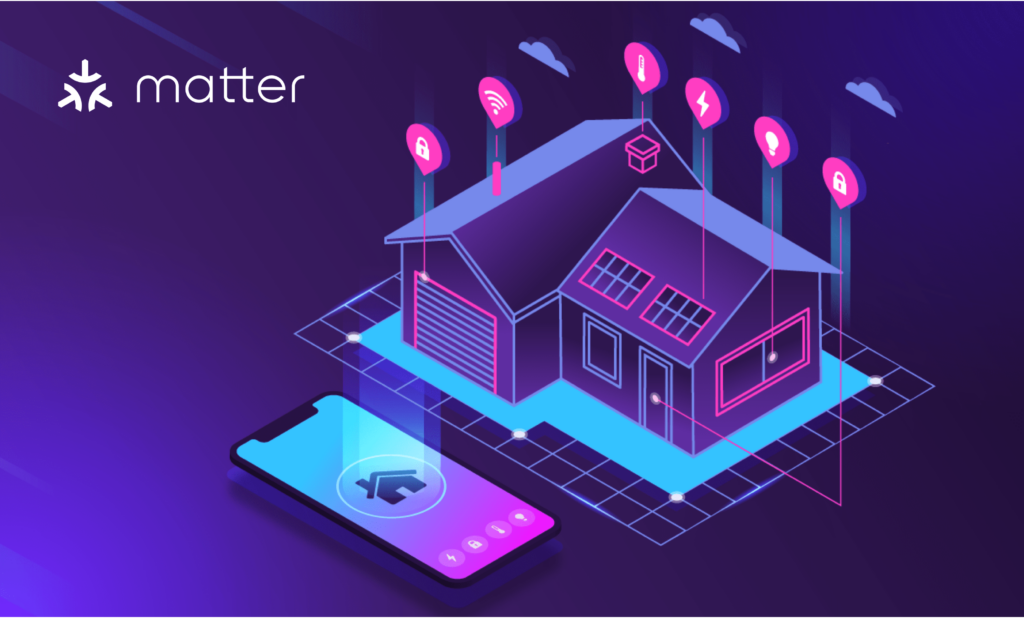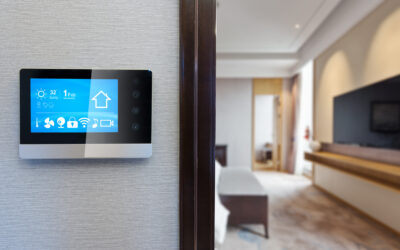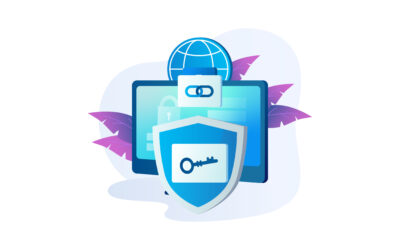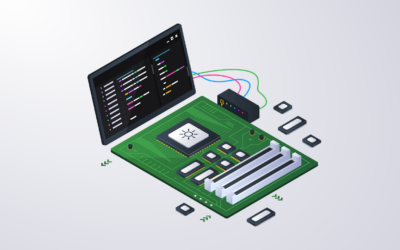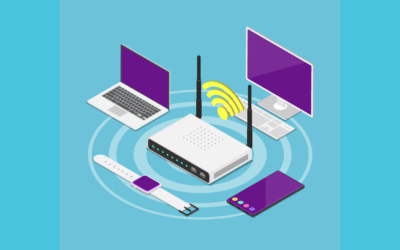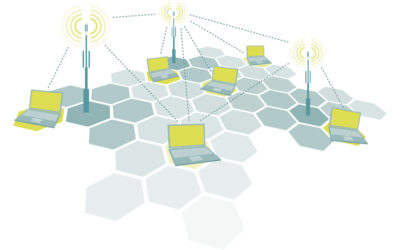Table of Content
- What Is Matter Smart Home?
- Matter Network Technologies
- Developing Matter Devices
- Building Matter Devices That Work with Alexa
- Matter Development for Google Home
- Security and Privacy Tenets for Matter Devices
- Matter Development with Blockchain Technologies
- Matter Device Certification Program
- Matter Development Services
Many IoT solutions for buildings and homes are fragmented, lacking cross-platform interoperability and an intuitive user experience (UX). As the IoT landscape evolves, the widespread adoption of connected solutions depends on addressing the challenges related to connectivity, security, and interoperability.
Matter is an initiative led by the Connectivity Standards Alliance (CSA) to promote a universal and open standard that facilitates seamless connectivity and interaction among IoT devices. To achieve this, Matter is developing a standard with robust tools and platforms.
The strength of Matter stems from the collaborative efforts of hundreds of its member companies. This community contributes not only knowledge and capital but also invaluable technical expertise, propelling the development of a transformative IoT standard.
The Connectivity Standards Alliance marked a significant milestone with the release of the Matter 1.0 standard and its accompanying certification program in September 2022, heralding the dawn of a new era for IoT interoperability. Furthermore, in October 2023, the CSA introduced the Matter 1.2 specification, expanding its scope by adding new device types and enhancements.
wHAT IS MATTER SMART HOME?
Matter Smart Home is an application layer and data model that works in certified ecosystems to deliver interoperability between devices, allowing them to communicate with other Matter devices, regardless of the ecosystem or network protocol.
Matter Smart Home Standard is an IP-based layer that can run over several network protocols, such as Wi-Fi, Thread, and Bluetooth (for device commissioning/setup).
The Connectivity Standards Alliance (CSA), a consortium of companies, pioneered this open-source technology. Their objective was to enhance the accessibility of these technologies and boost adoption rates. By doing so, they’ve enabled consumers to establish a smart home environment without the typical frustrations.
With the Matter standard, customers can effortlessly integrate their favorite devices and manage their smart home using their system of choice. Generally, Matter devices can be set up either through the manufacturer’s app or through a smart home system. These systems offer unique features and are compatible with any Matter-compliant controller (hub), app, or ecosystem.
One notable feature of Matter products is the “multi-admin” capability. This allows multiple administrators to connect with bridges, hubs, or other devices, thereby controlling Matter smart home devices from various systems. Essentially, the Matter standard simplifies linking smart home devices to any platform or app, eliminating the need for software or hardware modifications.
Additionally, silicon vendors are introducing Matter solutions for IoT developers and device manufacturers. Companies such as Silicon Labs, Nordic Semiconductors, Realtek, Espressif, and NXP are at the forefront, producing Matter System-on-a-chip (SoC) offerings.
Matter’s foundation is its robust architecture and layered approach. This design allows it to operate atop other communication layers without depending on their inherent security protocols. Matter devices utilize a specific application layer running on a hardware platform (MCU or SoC) on top of a software stack and communicate with other layers via APIs. Learn more about Matter’s architecture.
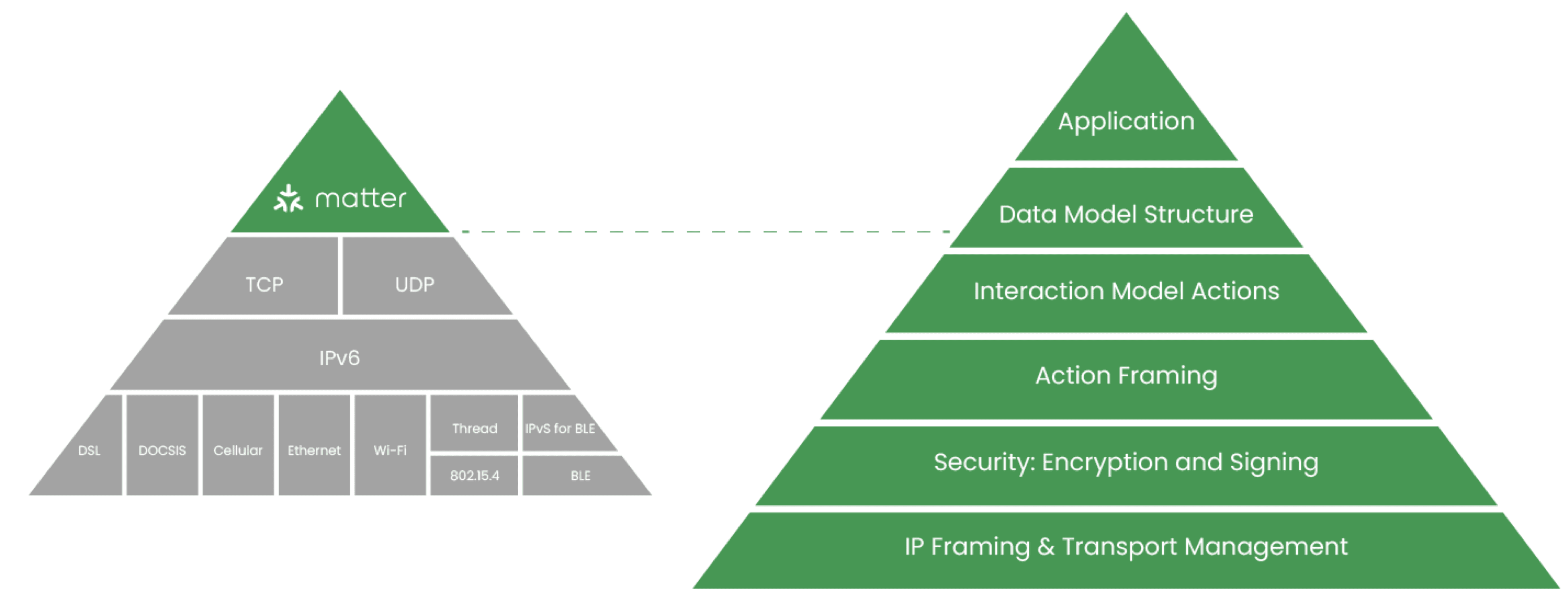
Matter Application Layer
Matter network technologies
Matter’s first specification release supports IPv6-based networks to achieve interoperability. Matter devices communicate with IP-based transmission protocols running one of the following technologies (network layer):
- Wi-Fi/WLAN
- Ethernet/LAN
- Thread
- Bluetooth Low Energy (for commissioning/device setup)
Matter controllers can be built into any device, hub, app, or panel to administer and control devices. Controllers typically connect to a local network via Wi-Fi and have cloud connections. Bluetooth Low Energy is used as an onboarding (commissioning) of Matter devices to the network. Also, Thread devices can connect using border routers. Border routers can also be built into other devices, apps, etc.
Devices in the network interact using the same Matter application protocol in a local network and can still connect to the cloud for other services, such as support, analytics, etc.
The Matter standard offers the flexibility to add devices that exist in homes or new products that use other technologies, connecting them through other protocols created by bridges and controllers. These would be non-native devices, but they can still interact with the Matter ecosystem.
Open-source reference implementations of Matter specifications benefit developers as they offer a code built on market-proven technologies (such as Zigbee) that are tested against many use cases and updated by the work group community.
Developing matter devices
Matter development has many benefits. Matter is an IP-based local protocol connectivity standard that provides better reliability and latency than cloud-to-cloud. It reduces development costs as developers build devices that work in any certified ecosystem and are easy to set up and integrate with other cloud services.
Matter devices must have a minimum of memory and processing requirements, support Wi-Fi or Thread technologies, have the capacity to run a Matter software library, and include radio compatibility.
Matter devices implement an application layer that runs on a hardware platform (MCU or SoC) on top of a software stack, communicating with other layers through APIs.
Matter initially targets the standard for common smart home products before supporting commercial devices. The main categories for Matter development are lighting and electrical, window treatments (blinds/shades), HVAC controls, TVs, access controls, safety and security, and access points and bridges. Other device types are also in the process of becoming certified.
BUILDING MATTER DEVICES THAT WORK WITH ALEXA
Devices using Matter can connect directly to Alexa without needing an additional hub or smart home skill. This ensures reduced latency and heightened reliability when Alexa controls these devices. Users can set up their Matter-enabled Amazon Echo devices and then command “Alexa, discover my devices” or manually add the device through the Alexa app.
Echo devices can then manage and locally connect Matter devices. Alexa provides several connection options for Matter devices, including Wi-Fi or Thread, and even offers support during internet outages.
Echo devices utilize the Matter 1.0 protocol specified by the Connectivity Standards Alliance (CSA). Alexa supports matter devices for Wi-Fi and Thread connections. Thread, an IPv6 wireless mesh networking technology, enhances the reliability and scalability of the network.
Alexa supports various Matter device categories like lighting, sensors, thermostats, etc. It is currently working on new device types supporting the new Matter 1.2 specification.
Amazon announced updates last year (2022), such as the API for credentials that will ease the setup of Matter devices, as well as the cloud-based API for Multi-Admin that allows connecting Matter admins to Matter devices through the Alexa Ambient Home Dev Kit.
In addition, the Alexa Connect Kit (ACK) SDK for Matter is a package that offers cloud connectivity to Matter devices, including over-the-air updates, metrics, and logs. The ACK SDK for Matter also provides cloud connectivity features that can give customers superior interoperability of Matter devices.
The ACK SDK will provide a Frustration-Free Setup (FFS)—an effortless setup for Matter devices—allowing consumers to add Matter-compliant devices to the network automatically through Alexa.
Echo devices enable control of Matter devices through voice activation. The Matter SDK will update existing Echos and allow commissioning and controlling Matter devices. Echo’s 4th generation will work as a Thread border router and continue as a Zigbee hub.
Alexas’s endpoint capabilities enable Echos as a Matter device administrator (path), add local connectivity using Matter, and reach local voice interactions in low latency situations (or without an internet connection).
MATTER DEVELOPMENT FOR GOOGLE HOME
Google has a suite of tools ready to develop Matter devices that work with Google Home and are compatible with other ecosystems. Google is also promoting the Matter ecosystem as the best option to bring new IoT products to market.
Clients are building and testing devices and apps to make them compatible with Matter. Google customers can control and manage Matter devices from the mobile Google Home app on Android, Google Assistant (voice control), or Google Nest Hub (border router).
Matter developers support clients from prototyping to certification and develop for Matter, leveraging the Google Home Device SDK and Matter SDK. The Matter Virtual Device Development Environment (MVD-DE) tests device interactions, including Google Assistant commands.
Matter developers also provide expertise by integrating the Home Mobile SDK for Android Studio, ensuring your Android app development initiatives are updated with Matter functionality and Google Assistant. Our goal is to help clients create top-notch, Matter-compatible smart home products.
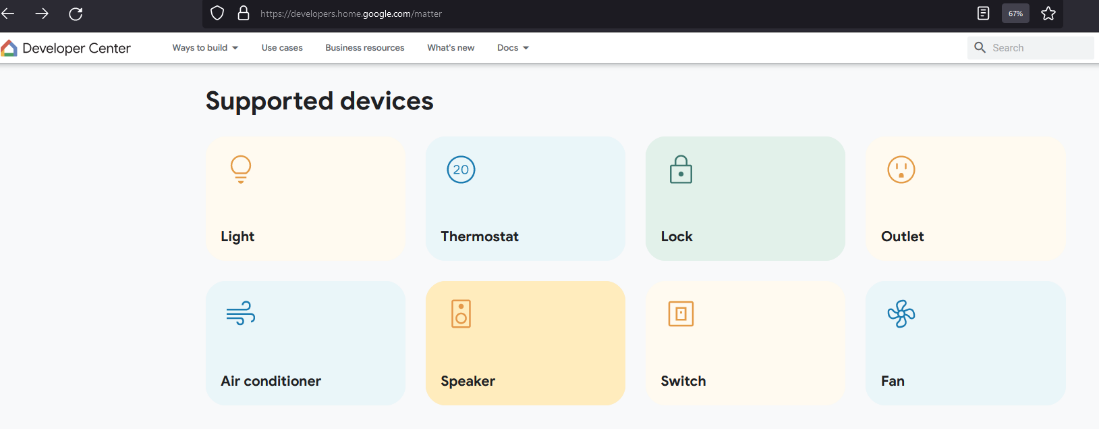
Developers can request access to Google’s Matter Private Beta Program to start working with Google Play Services Matter APIs and set up Matter devices in Google Home. Learn more about developing for Matter with Google here.
Security and Privacy Tenets for Matter Devices
IoT cybersecurity is one of the main worries for consumers when deciding on smart home solutions. It is important to mention that Matter has been created with high standards of security and privacy. Matter development is performed with the flexibility and capabilities to support many security features (security by design) and address potential future attacks. Devices must be provisioned securely with an identity (manufacturer ID) and firmware, secure encryption and authentication of communications, and a secure process that supports software/firmware updates (over-the-air).
Matter security is implemented in a layered approach that authenticates and provides an attestation mechanism for commissioning. Matter security implementation is self-contained and applies strong cryptographic standards, digital signatures, key exchanges, random number generators, and other mechanisms built into its definitions. Matter devices require AES 128-bit encryption security between devices and the cloud.
These mechanisms also establish sessions and implement the Distributed Compliance Ledger (DCL) technology for device commissioning (onboarding), attestation, and operations.
Matter Development with Blockchain Technologies
Matter is implementing a private blockchain-based ledger for Matter devices for validation of authenticity, certification, information, and security features that would allow monitoring of all devices in the network automatically—an ecosystem of trusted devices.
Having Matter devices working in a blockchain ledger (Distributed Compliance Ledger) allows users to verify the device software update history, receive alert about threats, and quarantine devices if necessary. This technology also allows authenticating and tracking devices at scale.
The Matter protocol specification has reference implementations available on a GitHub repository with a defined implementation as well as alternative integrations of security functionality.
Matter Device Certification Program
Developing Matter products requires compliance with the Connectivity Standard Alliance (CSA) specifications. Once the product is Matter certified, it is listed on the official site. It can use the Matter logo to show consumers it has been tested for interoperability in a Matter program.
Matter-certified devices or Certified End Product are tested for conformance with the standard, and compliant platforms are tested to a set of specifications before they are engineered into an end product. More than 4000 certified products and platforms are listed on Matter’s official site.
Matter Development Services
• Matter development—firmware applications, dedicated application layer
• App development—user experience (UX) design of Android Matter apps and iOS apps
• Architecture design—evaluate and select Matter hardware platforms
• Analyze use cases to select and implement functional security aspects—firmware attestation, authentication
• IoT open-source development agnostic mindset
• Compliance with Matter specifications and certification process
• Maintainability of Matter devices with the evolution of Matter revisions
• Adherence to Matter principles

